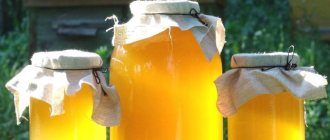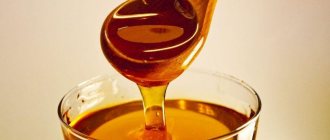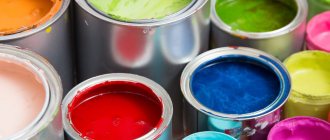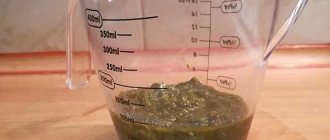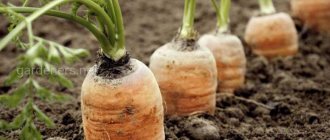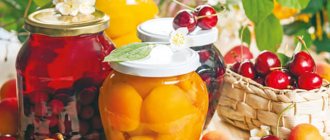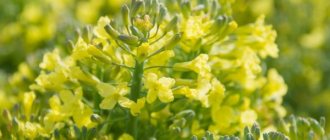How to prepare sugar protein glaze (icing) for painting gingerbread cookies:
The finished glaze dries quickly in the air and sets into a crust, so we’ll immediately prepare cornet bags for it. For these purposes, I use acetate film (sold in confectionery shops and flower shops) - the film produces cornets with a rather rigid spout, which can then be cut off to create a hole of the desired diameter. I don’t use icing attachments, I’ve never worked with them and I don’t know how convenient they are. But the question immediately arises: what to do if the hole becomes clogged? You can run a knife along the acetate spout in the direction of the hole and squeeze out a little glaze along with any clogged particles, but what should you do with the nozzle? In general, we will twirl cornets from film. For clarity, I will show the process on parchment (the film is transparent, it’s hard to see). So, we unwind a little film, fold it diagonally so that its two perpendicular sides coincide (you get a square folded diagonally).
We need half a square - this triangle, smooth and beautiful. Let's cut it off.
Now we fold it so that the nose of the bag falls in the middle of the long side of the triangle.
This is how you get a cornet bag.
The seams (internal and external) are secured with tape. We make cornets from film, remember?
This is what they look like when finished. If different glazes require different amounts, then for convenience it is better to make the cornets of different sizes.
Immediately cut off the spouts of the balls - pinch off a little at a time (we’ll figure out the required diameter of the hole later, the main thing now is not to cut off too much) so that the air comes out when we spread the glaze. Otherwise, the glaze will not penetrate deep into the cornet and it will be difficult to tie. Now that the preparation is complete, you can start glazing. Wash the eggs, the whites of which we will use for glaze, with soda in warm water and dry thoroughly. For pouring glaze (more liquid), weigh 40 g of protein. Add citric acid on your fingertip. It is believed that the acid makes the glaze shiny, the colors more vibrant and the taste less cloying. I would say that the shine depends rather on the grinding of the powdered sugar, and the color depends on the quality of the dyes and the humidity in the room where the gingerbreads dry. I’m generally silent about the cloying quality - well, it’s all sugar, what can you do? But I still add acid a little at a time, I don’t mind, what if it’s a secret ingredient?
Mix for a few seconds with a mixer so that the acid disperses and the protein becomes more homogeneous.
Then add powdered sugar little by little, mixing quickly with a mixer.
I add powder in three or four doses. By the way, all numbers (I mean weight) are relevant only for this powdered sugar. Of all the ones I tried (and there weren’t many of them; we have a very limited assortment on sale), this one worked, the others absolutely didn’t. It is important that the powdered sugar is finely ground - that’s what powder is, not sand. You can rub it with your fingers to make sure it's not too sharp and nothing crunchy. Starch in the composition is not scary, at least it doesn’t bother me.
But if you have a different powder, try to navigate by the consistency of the glaze. If you run a spoon over the surface of the glaze, grooves remain that close and align in a few seconds.
Do you always follow the correct storage of food/medicines and their product proximity?
Yes, of course, this is very important so as not to spend money on your health later.
43.91%
Not really, because there won’t be anything like going to the toilet.
24.72%
I look at it by appearance and if I use anything after heat treatment.
31.37%
Votes: 271
You can add one or two drops of aromatic essence to the finished glaze - any to your taste. After kneading, there are air bubbles in the glaze. To get them out, tap the container on your knee (you can do it on the table, but it will be noisy). And mix gently again. We will color the glaze immediately. In general, it is advisable to work with it immediately after preparation, without delaying it. After about three hours, the sugar will begin to melt and instead of a dense mass, you will get a transparent syrup with grains. Well, not literally right away, but the icing will tend towards this, it will noticeably float and the process of painting gingerbread cookies will become much less enjoyable. For coloring, we will separate the required amount of glaze into a smaller container and add gel food coloring. I use AmeriColor.
The dyes are very concentrated, so it’s better not to drip them into the glaze, but to dip a skewer or toothpick into the dye and add that amount.
Mix quickly and thoroughly.
If you need a more intense color, wipe the skewer with a napkin and repeat the procedure.
To obtain a more complex color, add another dye.
I mixed a little lemon into the green one and it turned out apple.
Spread the glaze into the cornet.
And tighten it tightly with tape.
In the same way, paint the rest of the glaze in the desired colors. Remember that glaze dries quickly when exposed to air. Either we paint it very quickly, or we cover the glaze with cling film in contact so that it does not dry out. We prepare the contour glaze in the same way - thicker. Typically, you need less outline glaze than fill glaze. That's why I have smaller proportions of ingredients. The thickness of the contour glaze is like this: it stretches behind the spoon like a flexible “bridge”.
If you get used to the consistency of the glaze and see it without a scale, it is convenient to prepare only the filling, color it, leave a little of each color and simply add powdered sugar there until it reaches the consistency of contour glaze. This makes it much faster and the colors match more accurately. As an option, they suggest preparing only the contour glaze and, accordingly, diluting it to fill it. Water. I don’t like water in the glaze - it makes the colors on painted gingerbreads float and migrate more readily, moving to neighboring areas. But this method is also widely used - perhaps you can get used to it. Good luck and inspiration - let everything work out as best as possible!
Mix quickly and thoroughly.
How long can you store gingerbread if you hate to eat it?
Lately I have often been asked the question: how long can gingerbread be stored?
Is it possible for a week? How about two? How about three weeks? And nothing will happen to him?
Therefore, let's look at this issue in detail and dot all the i's.
Do you use expired food for cooking at home?
Yes, the main thing is to process it if it is meat or expired kefir for pancakes.
27.72%
No, it is very dangerous and not useful.
36.37%
If the products have fungus or mold, then we throw them away; if they are a couple of days past their expiration date, we use them for food, even without heat or other treatment.
35.91%
Voted: 1952
Gingerbread cookies can be stored for a very long time . This is not a cream cake for you.
Some gingerbread makers claim that gingerbread has a shelf life of 6 months. And in Europe there was a tradition when gingerbread given for Christmas was eaten the next Christmas.
I haven’t tried storing gingerbread for half a year, much less a year, but I conducted an experiment and specifically stored gingerbread for 3 months. Exactly 3 months later, my family and I solemnly ate it, making sure that it perfectly preserved both freshness and aroma.
So why do our gingerbread cookies last so long? - you ask. After all, we didn’t add preservatives to them, everything is natural. And since it’s natural, it should deteriorate.
Gingerbread dough contains many natural preservatives.
Firstly, it's sugar and honey . Yes, of course, sugar and honey are natural preservatives, we all know this and make jam with sugar))).
Secondly, these are our gingerbread spices ( read more about spices here ): ginger, pepper, cloves, etc. In addition to the fact that they give us wonderful aromas, they also act as natural preservatives and prevent the gingerbread from spoiling.
Sugar icing is essentially also sugar, so after drying on the gingerbread it also does not spoil for a very long time.
If I put an end to this and ended my story, I would be wrong. There is one serious “But”.
Gingerbread cookies can dry out if stored for a long time. Indeed, due to the large amount of sugars, gingerbread dough is very hygroscopic. This means that it readily gives up moisture in a dry environment and absorbs moisture in a humid environment.
That is, if you put gingerbread in a saucer, and the saucer is on the table in your apartment, and the heating season is in full swing and the air in our apartments is dry, then within a day your gingerbread will become dry and stale.
Therefore, everything that I said about 3 months, half a year and a year is applicable only if you store the gingerbread in a tightly closed package: a container with a tight lid, an unopened box or a bag. In this case, the package creates its own microclimate and the gingerbread is quietly stored there, maintaining freshness and aroma.
Gingerbread does not need to be stored in the refrigerator; humidity changes are not necessary. In addition, the icing on the gingerbread in the refrigerator can become damp.
All your gingerbread needs is a tightly closed package and no direct sunlight.
But if your gingerbread is dry, it’s easy to fix. The gingerbread should be placed in a bag and the chopped apple should be placed in the same bag. And tie the bag (close it). The apple will give off moisture, and the gingerbread will gratefully absorb it and we will become fresh again.
SOS-Question
Answers
- Registration 10 Dec 2014
- Activity Index 31
- Author rating 0
- City of St. Petersburg
yenni, excuse me, but is it possible to draw on a soft gingerbread? I was absolutely sure that no. Or maybe put it in the oven for a couple of minutes to dry? for peace of mind, so to speak.
EvgeniyaF, in this thread you wrote about a store on a specific unit that sells packaging of different sizes. Evgeniya, if it’s not difficult, could you please tell me the address more precisely? very necessary. Thanks in advance for the tip!
If anyone knows places and places where you can buy budget packaging in St. Petersburg, I would be grateful.
- Registration Jan 9, 2012
- Activity index 4,469
- Author rating 237
- City Dnepropetrovsk
- Recipes 9
- Registration Jan 9, 2012
- Activity index 4,469
- Author rating 237
- City Dnepropetrovsk
- Recipes 9
- Registration June 9, 2011
- Activity index 1 105
- Author rating 80
- City of Stavropol region
Dear cooks, upload photos only through the cook gallery, otherwise they will disappear without a trace! (if you have questions about uploading photos to the site, write in a personal message) Tanya, if you would like comments on your work, do not forget to pay attention to the previous ones
Icing (icing for cookies and gingerbread)
Surely, on the Internet or at Christmas markets, you have seen cookies, gingerbreads or other confectionery products painted with icing that look almost like works of art. icing or, in other words, sugar glaze is used as such glaze Today I will tell you what it is and how to quickly and deftly prepare it.
Icing (English: “Royal icing”, translated as “royal icing”) is a protein paste for decorating desserts and all kinds of baked goods. The mass can be white or colored when food coloring is added to it. I will make icing that will be used as a frosting for gingerbread cookies and gingerbread cookies .
Ingredients
- egg white 1 pc.
- powdered sugar 200 g
- lemon juice 1/2 teaspoon
To prepare the icing, we need only two main ingredients - egg white and powdered sugar.
One C0 egg produces a fairly large amount of icing, enough for two dozen gingerbread cookies.
Master class on painting gingerbread cookies with icing
To decorate cookies and gingerbreads in New Year's style, you will need pastry bags. However, not every housewife has them in the kitchen, so you can replace them using plastic bags. To do this, just cut off a corner and that’s it.
To color the baked goods, you need to do several manipulations.
- Markings should be made with a colored edible felt-tip pen. Choose the pattern yourself.
- You can use white icing to outline the entire contour for the patterns, so that the glaze that we will fill in does not flow out.
- Fills in the remaining elements of the design and leaves to cool for half a day.
- If you need to make thin patterns, it is recommended to draw them with a needle or toothpick.
Interesting: Is it possible to store pumpkins in an unheated room?
Painted gingerbread cookies are ready for any holiday.
Preparation
We prepare all the necessary ingredients. Wash the egg thoroughly with soap. We carefully separate the egg white from the yolk.
Add sifted powdered sugar to the protein. It is necessary to sift; there may be sugar crystals in the powder that need to be removed. Otherwise, in the future they may slightly interfere with work, clogging the cut corner of the pastry bag.
Mix with a mixer or blender with a whisk attachment at low speed for 2 minutes. The glaze will gradually begin to turn white, this is due to protein oxidation. Next, add half a teaspoon of lemon juice, which will make the icing shine and shimmer a little in the light, and beat again for 3 minutes. The sugar-protein mixture will become a thick, homogeneous, white mass.
The actual icing is almost ready. The glaze dries quickly, so if you are not going to work with it for the next few minutes, it is better to cover it with cling film or a lid. Next, if you need icing of different colors, then put the icing in different containers and add food coloring of the color we need. I use Americolor gel dye. The quantity is determined by the intensity of the color you want to achieve. But it is worth considering that when drying the glaze darkens a little and the color becomes richer.
Mix. Look how beautiful it is!
But that's not all! As a rule, glaze is divided into 3 types: - thick - for gluing parts for a gingerbread house, drawing small details and inscriptions; - medium thickness - for the contours of drawings; — liquid — for filling inside contours.
We need to decide what pattern will be on our gingerbread cookies, this is necessary to understand how much icing of each type we will need.
Our thick icing is already ready. The consistency should be quite thick: the mass stays on the spoon and does not fall off even when turning the spoon on its side.
To obtain medium-thick icing, add a little water to the original mass and mix. It is better to add drop by drop so as not to overdo it. If the mass is still thick, then repeat the process. The consistency is medium thick: the mass on the spoon slowly slides down when turned.
To obtain liquid icing, add a little more water to the original mass and mix. If the mass is still thick, then repeat the process. The consistency is slightly thicker than condensed milk. The mixture drips off the spoon when turned on its side. We do the filling like this: first, use thick icing, draw a line along the perimeter of the future filling, and then fill the inner space with liquid icing.
We put our mixture into pastry bags. You can use regular heavy duty bags or even zip bags if you don't have piping bags. Or a pastry syringe.
We cut off the edge and start drawing. The main thing is not to be afraid of this matter. Gingerbread cookies will still turn out to be a decoration for any tea party. I have quite a bit of artistic talent, but I still drew it well, it seems to me. So, you can apply the glaze however you like, as your heart dictates. In general, there are no restrictions. Children simply adore this kind of creativity; it’s the best thing to do with them. The simplest option is to make a solid fill with one color. First, we make a contour with thick icing, which we fill with liquid icing. A toothpick will help to carefully distribute everything inside and smooth it out.
Two-color mitten. From the photo, I think everything is clear: first we draw the outline, fill it, then draw white “polka dots” on the red and use a toothpick to draw it through the center of the circle. The final touch: sprinkle the base of the mitten with sugar.
Another option for decorating gingerbread cookies: draw several lines into the filled outline with liquid icing of a different color and immediately draw a toothpick along the lines perpendicular to them, first in one direction, then in the other, and so on. The result is such a simple but beautiful drawing.
Icing dries in different ways: thick icing takes 30 minutes, liquid icing dries for a couple of hours at room temperature before pouring. If a thick layer of icing was placed on the cookies, the time will increase. The icing will dry for sure in a couple of hours!
The main thing in this matter is a creative approach. Experiment when drawing! You can involve the whole family, as this is quite a fun and exciting process. If you didn't use it all at once, you can store it in a tightly closed container for a couple of weeks. Remember that the glaze hardens quickly when exposed to air.
Icing (English: “Royal icing”, translated as “royal icing”) is a protein paste for decorating desserts and all kinds of baked goods. The mass can be white or colored when food coloring is added to it. I will make icing that will be used as a frosting for gingerbread cookies and gingerbread cookies .
White fondant for gingerbread baking - cooking secrets
- obligatory baked goods on New Year's tables. But you don't have to wait until the holidays to treat yourself to a treat. And if gingerbread baking seems rustic to you, then you simply must cover it with white fondant. To prepare white glossy fondant, we need the following products:
- a glass of granulated sugar;
- spoon of lemon juice;
- protein.
Sift granulated sugar through a fine sieve. There should be no lumps or other inclusions. Beat the chilled egg white into a dry bowl, and begin to gradually add granulated sugar, stirring vigorously with a whisk. When the sand runs out, add a teaspoon of lemon juice. That's it, the fondant is ready to decorate the gingerbread pastries.
If you don't know how to apply fondant to a treat, here's a hint: trace the outline of the baked goods, and draw themed designs in the middle of the treat. It could be snowflakes, hearts, balls, a house.
Glaze: 11 secrets and six simple recipes
Sweet, shiny, glossy - it's all icing. It is very difficult for confectioners to do without it. It is used to cover cakes and pastries, to paint on gingerbread cookies and cookies, and to fill the tops of muffins and Easter cakes.
Glaze is not only beautiful, but also useful. Thanks to it, baked goods stay fresh longer. In addition, this cupcake decoration is very easy to prepare and not expensive. The only products you need are sugar and water. This is for the simplest frosting. But there are many recipes for this decoration; sometimes it seems that as many confectioners in the world, there are as many recipes, or even much more: everyone has at least two favorites.
How to make gingerbread icing
Many housewives who bake delicious gingerbreads and cookies for their households prefer to paint and decorate their creations.
For beginners, paint gingerbread cookies with icing using a technique for beginners, for example - a blanket, or with simple, not complex designs. Gingerbread cookies are perfect for icing.
Below is a method on how to make gingerbread cookies with icing for beginners. Preparing such decorated delicacies is not difficult.
What you will need
- wheat flour – 300 g;
- butter – 100 g;
- sugar – 100 g;
- 1 egg;
- honey – 2 tablespoons;
- baking soda – ½ teaspoon;
- ground ginger and cinnamon - one teaspoon each.
To prepare the glaze you will need the following ingredients:
- dry protein 4-5 teaspoons;
- 55 ml of cooled boiled water;
- pure lemon juice ½ - 1 teaspoon;
- powdered sugar – 400 g.
Sequencing
To make baked goods with hand-drawn icing designs, you need to do everything gradually. We start by baking gingerbread cookies.
- Heat the oil to room temperature.
- Sift flour, add soda, cinnamon and ginger. Stir. To give it a brown color, add cocoa powder.
- Place sugar and butter in a mixing bowl. Beat.
- Pour the egg into the mixture, stir, add honey. Continue whisking.
- Gradually add the mixture of flour and the rest, continuing to beat.
- Remove the finished dough from the bowl, sprinkle with flour and leave to infuse in the refrigerator for several hours.
The dough is ready, it should be rolled out, and future gingerbread cookies should be cut out with molds. Place the finished figures in an oven preheated to 180 degrees for a short time, about 7 minutes.
- Place the whites in a mixer bowl, add a little water and mix with a spoon. Leave the mixture for 10 minutes.
- After this time, add lemon juice and begin to beat until small bubbles form and the mixture increases in volume. The process takes about 5 minutes.
- Add powder and beat again on low.
- Now if the mixture turns out liquid, add powdered sugar.
The glaze used to decorate gingerbread cookies should be thick. Once prepared, you can use it.
You can make your baked goods look elegant with the help of icing. For a thicker consistency, add more powdered sugar. To apply the glaze, you should use a nozzle; this is the only way to get beautiful gingerbread cookies.
Painting gingerbread cookies with icing is a fascinating activity that can captivate you so much that you forget about the time. Painted baked goods look very creative, and the main thing is that you can create a pattern on it of absolutely any shape and size. So, we bake gingerbread cookies and select the icing with which we will decorate the fragrant confectionery product.
Dyes
It is often recommended to add food coloring to the glaze; with it, the color turns out bright, and the product takes on a festive, cheerful look. Of course, there is nothing wrong with using food coloring from a bag, but you can add natural coloring products to the icing. For example, a spoonful of raspberry jam - you get a red color and a magical raspberry aroma. A pinch of turmeric and a piece of butter will give you an intense orange tint.
Secret: it’s better not to use porous chocolate for the glaze. And if you add a spoonful of cocoa to the chocolate, the color will be more saturated.
About the consistency of icing
– Why do dips appear on small parts?
- This is the wrong consistency. You must remember: if the part is small, then the consistency of the icing should be thicker. Dips can also appear from bubbles in the glaze.
– If you change the proportions given on the label, will something terrible happen?
– Nothing bad will happen if the error is literally 5 g. You can create any consistency from our icing that you need.
– Why can the consistency of icing become heterogeneous or thin out?
– This can happen from over-beaten icing. This can also happen when the icing bag sits for a long time. To do this, you just need to knead the bag and continue working.
– Why can the consistency of icing be uneven?
– This can happen if you added cold water or did not infuse the mixture before whipping. And also from the weathered crust - it just got into the icing.
How to apply?
Liquid glaze for Easter cakes and cupcakes is applied with a brush. You can apply it in several layers. The glaze for painting is applied using a pastry syringe. By the way, you can use a regular disposable syringe.
Simple glaze
200 g powdered sugar
4 tbsp. l. hot water
Step 1. Mix powder and water, put on low heat.
Step 2. Cook, stirring, until the glaze is smooth. Approximately 5-7 minutes.
Step 3. Pour hot glaze over gingerbread cookies or buns.
Egg yolk glaze
1.5 cups powdered sugar
3-4 tbsp. freshly squeezed orange juice
Step 1. Beat the yolks with orange juice until a stable foam forms.
Step 2. Gradually introduce previously sifted powder. Stir everything until smooth.
Step 3. Cover the cake or cookies with icing, dry in the oven at a temperature of approx. 100 C.
Glaze with rum
1 cup powdered sugar
1 tbsp. l. hot water
Step 1. Sift the powdered sugar.
Step 2. Add water and rum and grind very thoroughly. Cover cupcakes or pastries.
Chocolate glaze
1 tbsp. l. butter
100 g powdered sugar
Step 1. Break the chocolate into pieces, add hot water and heat until the chocolate dissolves.
Step 2. Then add softened butter and powdered sugar and grind into a homogeneous glaze.
Protein glaze
Good to use for patterns
1 cup powdered sugar
1 tsp lemon juice
Step 1. Beat the whites until stiff foam.
Step 2. Sift the powder into the egg whites and beat very well again. Add lemon juice.
Step 3. Fill a pastry syringe or bag with icing. Apply a pattern to a cake, cookies or gingerbread.
Butterscotch icing
200 g hard toffees
40 g butter
1/4 cup milk
1-2 tbsp. l. powdered sugar
Step 1 . Heat butter and milk in a saucepan.
Step 2. Add toffee and powder, cook until the candies are completely dissolved, stirring constantly.
Step 3 . Apply to the cake in several layers.
200 g hard toffees
IL-Icing for gingerbread, 500 g
Ingredients: powdered sugar, pasteurized protein, potato starch, citric acid, guar gum, maltodextrin, crystalline vanillin, titanium dioxide.
1. Add water according to instructions.
2. Beat the mixture at medium speed for 5-8 minutes. The longer you beat, the faster it dries, but the gloss may disappear.
3. Dilute the mixture with water to the desired consistency.
4. Transfer to a pastry bag.
If you need a small amount of icing, you can dilute a spoonful of the mixture in a few drops of water.
To preserve the softness of the gingerbread, it is recommended to dry the filling naturally for about a day (uniform pouring on a 10-12 cm gingerbread; small parts or partial filling dries faster) at a relative humidity of 20% and an air temperature of 20-25C. For emergency drying, we recommend drying the glaze in the oven for 10 to 45 minutes in convection mode at 50-70C. Drying in the oven affects the softness of the gingerbread. For contour and decoration, thicken by adding dry mixture.
For long-term drying: gradually add the sifted dry mixture into warm water at 40-50C, mix with a spoon or in a bowl with a mixer (for planetary mixers, use the paddle attachment) at low speed until completely dissolved.
Ready icing can be easily colored with gel or dry dyes.
Store the dry mixture at a temperature not exceeding +40 C and a relative humidity of not more than 75%.
To preserve the softness of the gingerbread, it is recommended to dry the filling naturally for about a day (uniform pouring on a 10-12 cm gingerbread; small parts or partial filling dries faster) at a relative humidity of 20% and an air temperature of 20-25C. For emergency drying, we recommend drying the glaze in the oven for 10 to 45 minutes in convection mode at 50-70C. Drying in the oven affects the softness of the gingerbread. For contour and decoration, thicken by adding dry mixture.
Question answer
On this page you will find answers to questions about gingerbread painting that are most often asked by beginners. The page is structured according to the Question-Answer pattern. To see the answer, click on the blue plus sign.
BY NOZZLES
The main, most famous manufacturers of confectionery equipment: Wilton, Ateco, PME. The attachments from these companies are professional, and therefore the most expensive.
There are Chinese and South Korean attachments - they are cheaper (around 100 rubles). I have both professional ones and simpler ones. I live in a small town, so my choice is limited - I bought those that I found on sale in my city if I needed the nozzle urgently. Some of them were ordered from online stores. But, to be honest, I didn’t see much difference between the cheap Chinese ones and the expensive ones. But I noticed one strange nuance: Wilton nozzles, despite the fact that they are more expensive, quickly darken: I bought brand new shiny ones, after only a year dark spots appeared on the shiny surface - metal oxidation, perhaps. But this feature is purely aesthetic and does not affect functionality. Just make sure that the cheap attachments are of good quality: there is no rough seam with rivets (I saw these once) - the attachment should be a solid cylindrical one, without a seam.
For plastic nozzles
Yes, I know, there are some for sale. But I've never used it, so I can't say anything. BUT: as far as I know, plastic nozzles cannot be boiled. And this is important, since it can be difficult to rinse them well (I use a toothpick for this and, after mechanical cleaning, boil for 10-15 minutes)
By cornetics
You often ask how to make cornets and why I don’t use them in video master classes.
I don’t use cornets because I simply don’t think it’s necessary to spend time making them. I find it easier to work with pastry cutters. Moreover, now they are very affordable - you can buy them at any confectionery store or order them from an online store if you live in a small town.
For the filling consistency, it is convenient to use ordinary small bags with a zip fastener - they are strong enough and will not tear during operation or pastry bags without a nozzle.
But to work with contour consistency, I prefer a pastry bag with a nozzle. Yes, if you buy different shapes and sizes, then, of course, it will not be cheap. But, girls, they are IRON, they will last for a long time, if not for the rest of your life. Moreover, cornets can only replace attachments with a round outlet, while others, special ones - for leaves, roses, petals, various textured ones - are no longer available (although, I know, leaves can be made with a cornet).
I think that you should not skimp on tools if you want to professionally paint gingerbread cookies and make money from it. And for lovers who make gingerbread for themselves, their children, friends and relatives, a couple or three attachments will be enough. Or you can even get by with zip bags.
What size nozzles do I use in specific videos?
The diameter of the nozzle must be chosen depending on the size of the gingerbread: if the gingerbread is small, then the outline and painting made with a nozzle with a large diameter will look rough. But for large gingerbread cookies, the contour needs to be made with a nozzle with a large diameter - a thin contour thread simply cannot hold a large amount of filling glaze. For example, in the video I paint a gingerbread with an 8cm diameter, and you decide to decorate a 15cm gingerbread in the same way. Of course, you will need a different size nozzle.
As for pouring glaze: if you need to fill a large space, then choose a nozzle with a larger hole diameter in order to have time to fill this large space, level the glaze, remove air bubbles - all this must be done before the glaze begins to dry. If you need to carefully fill a small area, you will need a nozzle of a smaller diameter.
For filling, I often use not even nozzles, but ordinary zip bags - it’s very convenient, you can make a hole of any desired diameter.
Curly nozzles
Different manufacturers have their own numbering. And again, the size of the nozzle depends on the size of the gingerbread. For example, in a video master class I paint an 8cm gingerbread, and you decide to decorate a 5cm or 15cm gingerbread in the same way - the result will be completely different if you purchase an attachment of the size indicated in the video. Therefore, in the comments on the master class page, I indicate the size of the gingerbread so that you can adjust the size of the nozzle.
It is more convenient to navigate by the appearance of the outlet, so in the video I try to show the shape of the nozzle.
WHERE TO BUY PASTRY EQUIPMENT, DYES, GINGERBREAD PACKAGING
All this is sold in confectionery stores. Residents of large cities should not have problems with this. And for those who live in small towns, there are online stores for confectioners that send orders by Russian Post to any city. In addition to the order amount, 300-400 rubles will be charged for shipping.


